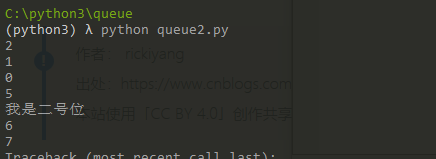---恢复内容开始---
python的线程学习
用处 pocpiliang脚本的编写
函数式:调用 _thread 模块中的start_new_thread()函数来产生新线程。语法如下:
_thread.start_new_thread ( function, args[, kwargs] )
参数说明:
- function - 线程函数。
- args - 传递给线程函数的参数,他必须是个tuple类型。
- kwargs - 可选参数。
import _thread import time 为线程定义一个函数 def print_time(threadName,delay): i=0 while i<5: time.sleep(delay) i=i+1 print("%s,%s"%(threadName,time.ctime(time.time()))) try: _thread.start_new_thread(print_time,("first",2,)) _thread.start_new_thread(print_time,("second",4,)) except: print("太快了")
我们可以看见 这个线i<5发送四次包 first发两次 second发一次

线程模块 Python3 通过两个标准库 _thread 和 threading 提供对线程的支持。 _thread 提供了低级别的、原始的线程以及一个简单的锁,它相比于 threading 模块的功能还是比较有限的。 threading 模块除了包含 _thread 模块中的所有方法外,还提供的其他方法: threading.currentThread(): 返回当前的线程变量。 threading.enumerate(): 返回一个包含正在运行的线程的list。正在运行指线程启动后、结束前,不包括启动前和终止后的线程。 threading.activeCount(): 返回正在运行的线程数量,与len(threading.enumerate())有相同的结果。 除了使用方法外,线程模块同样提供了Thread类来处理线程,Thread类提供了以下方法: run(): 用以表示线程活动的方法。 start():启动线程活动。 join([time]): 等待至线程中止。这阻塞调用线程直至线程的join() 方法被调用中止-正常退出或者抛出未处理的异常-或者是可选的超时发生。 isAlive(): 返回线程是否活动的。 getName(): 返回线程名。 setName(): 设置线程名。
import threading import time class myThread(threading.Thread): def __init__(self,threadID,name,counter): threading.Thread.__init__(self) self.threadID = threadID self.name =name self.counter =counter def run(self): print("开始线程"+self.name) print_time(self.name,self.counter,5) print("退出线程"+self.name) def print_time(threadName,delay,counter): while counter>0: time.sleep(delay) print("%s: %s" % (threadName, time.ctime(time.time()))) counter=counter-1 #创建新线程 thread1 =myThread(1,"第一个线程",1) thread2 =myThread(2,"第二个线程",2) # 开启新线程 thread1.start() thread2.start() thread1.join() thread2.join() print ("退出主线程")
可以看见这里我们调用线程

那么接下来重点来了
多线程
多线程的优势在于可以同时运行多个任务(至少感觉起来是这样)。但是当线程需要共享数据时,可能存在数据不同步的问题。
考虑这样一种情况:一个列表里所有元素都是0,线程"set"从后向前把所有元素改成1,而线程"print"负责从前往后读取列表并打印。
那么,可能线程"set"开始改的时候,线程"print"便来打印列表了,输出就成了一半0一半1,这就是数据的不同步。为了避免这种情况,引入了锁的概念。
import threading import time class myThread (threading.Thread): def __init__(self, threadID, name, counter): threading.Thread.__init__(self) self.threadID = threadID self.name = name self.counter = counter def run(self): print ("开启线程: " + self.name) # 获取锁,用于线程同步 threadLock.acquire() print_time(self.name, self.counter, 3) # 释放锁,开启下一个线程 threadLock.release() def print_time(threadName, delay, counter): while counter: time.sleep(delay) print ("%s: %s" % (threadName, time.ctime(time.time()))) counter -= 1 threadLock = threading.Lock() threads = [] # 创建新线程 thread1 = myThread(1, "Thread-1", 1) thread2 = myThread(2, "Thread-2", 2) # 开启新线程 thread1.start() thread2.start() # 添加线程到线程列表 threads.append(thread1) threads.append(thread2) # 等待所有线程完成 for t in threads: t.join() print ("退出主线程")

可以看见是先开始线程1然后线程一完了在开线程二
线程优先级队列( Queue)
线程优先级队列( Queue) Python 的 Queue 模块中提供了同步的、线程安全的队列类,包括FIFO(先入先出)队列Queue,LIFO(后入先出)队列LifoQueue,和优先级队列 PriorityQueue。 这些队列都实现了锁原语,能够在多线程中直接使用,可以使用队列来实现线程间的同步。 Queue 模块中的常用方法: Queue.qsize() 返回队列的大小 Queue.empty() 如果队列为空,返回True,反之False Queue.full() 如果队列满了,返回True,反之False Queue.full 与 maxsize 大小对应 Queue.get([block[, timeout]])获取队列,timeout等待时间 Queue.get_nowait() 相当Queue.get(False) Queue.put(item) 写入队列,timeout等待时间 Queue.put_nowait(item) 相当Queue.put(item, False) Queue.task_done() 在完成一项工作之后,Queue.task_done()函数向任务已经完成的队列发送一个信号 Queue.join() 实际上意味着等到队列为空,再执行别的操作
队列1 单向先进先出队列
import queue #单向队列 q = queue.Queue(5) print(q.maxsize) for i in range(4): q.put(i) print(q.get()) print(q.qsize()) #先进后出队列

此时q.get()从队列里面取出来的是0 q.qsize还剩3个所以输出3
如果代码改成
import queue
#单向队列
q = queue.Queue(5)
print(q.maxsize)
for i in range(4):
q.put(i)
print(q.get())
print(q.qsize())
#先进后出队列
那么将输出 进一个出一个 那么队列为空 q.qsize为0

接下来是先进后出队列
import queue q =queue.LifoQueue() for i in range(5): q.put(i) print(q.get()) print(q.qsize())
那么看看运行效果

和我们预想的一样
接下来是优先级队列的讲解
import queue q =queue.PriorityQueue() q.put((5, 5454)) q.put((5, 532566)) q.put((3, 555)) q.put((7, 344)) print(q.get()) print(q.get())
优先级队列put进去的是一个元祖,(优先级,数据),优先级数字越小,优先级越高 话不多说我们看代码
如果有两个元素优先级是一样的,那么在出队的时候是按照先进先出的顺序的。

接下来是双端队列的讲解 看代码
import queue
q =queue.deque()
for i in range(3):
q.append(i) 尾部加入
for c in range(5,8):
q.appendleft(c) 首部加入
q.insert(2,"我是二号位") 任意位置插入
for i in range(10):
print(q.pop()) 从尾部出
